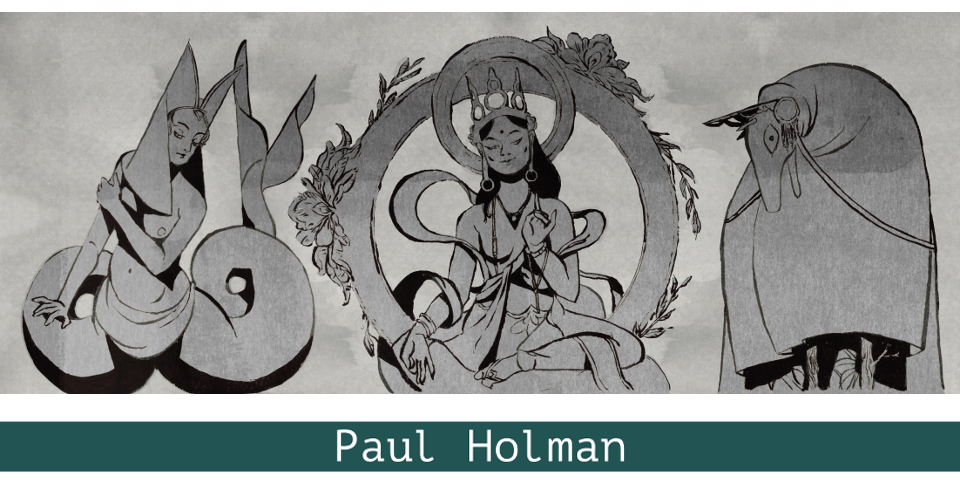While it is no surprise to find Bill Griffiths engaged upon a radical transformation of an ancient form, this work differs from its most obvious models in that it is a “hymn of” not a “hymn to” Jesus and Ayesha, implying either that the text is about them, a form of words which the author uses in the titles of his praise songs or, more likely in this context, that it is to be imagined as voiced by them, as in the “Hymn of Jesus”, words to accompany a ritual dance given in the Acts of John, which Griffiths may well have known through Holst’s choral setting: I suspect this work, composed during the First World War, is also referenced by the “Dance Hymn” at the end of Further Songs & Dances of Death.
An alternate reading of the title would be that it does not refer to the entire poem, but to the words that issue from the boy-God between lines 31 and 50, although I can detect no trace of Ayesha in that passage. That name could be an echo of Asia, a half sister of Jesus mentioned in the “History of Joseph the Carpenter”, which occurs in M. R. James’ Apocryphal New Testament, another likely source for Griffiths to have encountered, or refer to the beloved third wife of Muhammad, who fits with the themes of this work both as a young girl wed to the Prophet, and as the commander of a doomed army, chanting war cries and martial poetry in the midst of battle. As fantastic literature is a dependable point of reference in Griffiths’ writing, it is entirely possible that H. Rider Haggard’s She might also be a presence here.
The text begins with a series of six unrhymed tercets. Its first line delivers a jarringly artificial image: “tiles of smoke”. Perhaps components of a game or model, in keeping with the juvenile theme of the title, these hang on, not over, a site at once “quick moving” and “lifeless”. The presence of “black lava” in the next line suggests the lava fields outside Medina, and it could be the case that each of the three following tercets, which describe a mudslide, an inundation of waters, and a riverine landscape, relates to a different location, but I think it more likely that what we have here is an account of the formation, or reformation, of a world: in either case, the visual information is sufficiently oblique for me to wonder if Griffiths is selecting fragmentary details from a sequence of images which I have not identified. In the expansive fifth tercet, which takes half as long again to speak aloud as any of the others, the viewpoint shifts up towards the clouds, where a succession of figures appear.
Or perhaps it has been directed towards the sky all along, and the scenes described in the poem, which are progressively “lifeless”, “unconsidered likely for life” and finally populated, if only by cloud forms, have been unfolding overhead: it could be argued that the text itself is an exercise in cloud-gazing or cloud-divination. The philosophy of Anaximenes comes to mind, in which successive worlds are products of the condensation and rarefication of the deity, air: this possibility is reinforced by the presence of the isolated word “respiration”, the breath of life, among the glorious catalogue of clouds that closes the poem.
In the final tercet, Cadmus and Shonk, who also makes an appearance in the later “Guide to the Giants of England”, loom above the populace. In Griffiths’ work, “jiants” are always “placed against some … egalitarian ethic”, and are to be overthrown. Both these figures connect with the “snaking river” and “bank of dragons” mentioned earlier in this section through an odd conflation of legends. While the memorial tablet of Piers Shonks at the church of St. Mary in Brent Pelham, Hertfordshire, links his name with Cadmus and St. George as a dragon slayer, local folklore identifies Shonk as a giant who fought and defeated Cadmus, a rival giant resident in the nearby village of Barkway.
